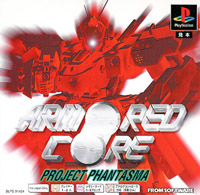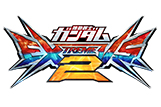Reviews: Armored Core Project Phantasma (7/10)
Posted on : 08-05-2011 | By : Cacophanus | In : Reviews
Hardware: PlayStation
2
 Shortly after the July 1997 release of the first Armored Core, From Software were quick to capitalise on the then new series’ initial success. So in December of the same year, a scant five months later, another Armored Core game was released with the subtitle of Project Phantasma. Following the player after the events of the first game and their unearthing of a sinister project within the Wednesday Corporation. It also featured much more overt characterisation, with the main antagonist by the name of Stinger being voiced by none other than Sho Hayami. However, despite the strong foundation of the previous game the painfully short development cycle did take its toll.
Shortly after the July 1997 release of the first Armored Core, From Software were quick to capitalise on the then new series’ initial success. So in December of the same year, a scant five months later, another Armored Core game was released with the subtitle of Project Phantasma. Following the player after the events of the first game and their unearthing of a sinister project within the Wednesday Corporation. It also featured much more overt characterisation, with the main antagonist by the name of Stinger being voiced by none other than Sho Hayami. However, despite the strong foundation of the previous game the painfully short development cycle did take its toll.
Unlike the first game, Project Phantasma shortened the main campaign quite drastically. To make the each mission more of challenge, the enemies themselves became suitably armored. Whilst not quite bullet sponges, the amount of ammunition required to take out the beefier MT’s did make the missions more of a resource management exercise in some instances. The missions themselves were more involved than the previous game too, with one memorable stealth level disallowing the player to go airborne in case they were detected by radar. Not to mention the microwave power receiver station mission, where flying above the structure resulted in the player getting fried. The slightly odd aspect to the game’s balancing though was how an all new arena mode pretty much undermined the increased challenge of the new missions.
Previously, the ranking Ravens were displayed in a simple leaderboard. As the player progressed through the first game, they inched their way up the Raven hierarchy. In Project Phantasma the leaderboard became an arena, where each rank had to be earned in one-on-one AC combat against another Raven. Naturally, the initial matches were very straightforward but the further the player went up the pecking order the more they ended up displaying the somewhat dreaded Human Plus ability set. That aside, each match netted large sums of cash but importantly eschewed any cost penalty in terms of armor and ammo lost. This meant that the harder missions were made far easier on account of the fact the player had a much larger bank account due to their arena winnings.
In some ways, this increase in player funding was taken into account (via the aforementioned increased enemy armor and finite player ammo) but the game was far less functionally considered than its progenitor. However, this was counter balanced against an all new approach to the game’s usage of characterisation. Specifically, that of two characters; Sumika and Stinger.
Sumika piloted a custom pink AC and was the player’s main financier. Subsequently, this resulted in Sumika being the player’s ally and rationalising the events happening around them. Juxtaposed to this was the very pompous antagonist Stinger, which in true anime fashion was overly enigmatic as to his real motives. Again, Stinger also initially had his own custom AC which he later swapped out for the titular experimental MT Phantasma.
In parts, the new characters did help the smaller number of missions make sense but on the other it did feel very odd. As the custom AC’s both characters piloted were obviously meant in place of character portraits. Leaving mecha the size of buildings to infer emotion, which can work in certain circumstances as long as it is done sparingly. Unfortunately, the entire game had this setup and it resulted in partially nullifying the sense that these were very large machines.
This wasn’t to say that Project Phantasma wasn’t fun. As it was in some ways deeply satisfying, with the overtly powerful weapons making the game very compelling. Admittedly this was in a more guilty pleasure sense rather than anything well wrought. The characterisation was a nice touch too, despite the fact the custom AC’s parts weren’t usable by the player (something that would be true until Nexus came along several years later).
Overall then, Project Phantasma was a somewhat experimental and clearly rushed game. Whilst it was a good romp and many of the new elements would grace future Armored Core games, it did still feel lacking. Interestingly, this wasn’t lost on the studio and the following games would receive far longer developmental cycles. So in that sense, Project Phantasma’s legacy was ultimately a positive one.
Tamashii: 7/10











If it weren’t for the Human Plus abilities in the high arena opponents, it would probably only take me a couple hours to finish this game with my AC from the original.
I’m going back through the entire series, getting footage to make a bit of a retrospective, and it surprises me how much longer this game took than Master of Arena to finish the standard arena and missions. Then again, MOA has Ranker Mk and Ex Arena, so there’s a lot more material overall in that one.
I think the proof that “expansion pack” style games would work well in the AC franchise ultimately paid off once Silent Line hit. Another Age was pretty neat, but neat is about as far as it got.